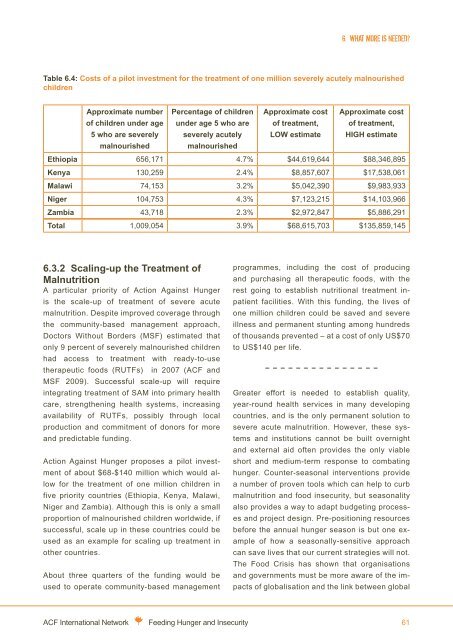Feeding hunger and insecurity
Feeding hunger and insecurity
Feeding hunger and insecurity
- No tags were found...
You also want an ePaper? Increase the reach of your titles
YUMPU automatically turns print PDFs into web optimized ePapers that Google loves.
6. what more is needed?Table 6.4: Costs of a pilot investment for the treatment of one million severely acutely malnourishedchildrenApproximate numberof children under age5 who are severelyPercentage of childrenunder age 5 who areseverely acutelyApproximate costof treatment,LOW estimateApproximate costof treatment,HIGH estimatemalnourished malnourishedEthiopia 656,171 4.7% $44,619,644 $88,346,895Kenya 130,259 2.4% $8,857,607 $17,538,061Malawi 74,153 3.2% $5,042,390 $9,983,933Niger 104,753 4.3% $7,123,215 $14,103,966Zambia 43,718 2.3% $2,972,847 $5,886,291Total 1,009,054 3.9% $68,615,703 $135,859,1456.3.2 Scaling-up the Treatment ofMalnutritionA particular priority of Action Against Hungeris the scale-up of treatment of severe acutemalnutrition. Despite improved coverage throughthe community-based management approach,Doctors Without Borders (MSF) estimated thatonly 9 percent of severely malnourished childrenhad access to treatment with ready-to-usetherapeutic foods (RUTFs) in 2007 (ACF <strong>and</strong>MSF 2009). Successful scale-up will requireintegrating treatment of SAM into primary healthcare, strengthening health systems, increasingavailability of RUTFs, possibly through localproduction <strong>and</strong> commitment of donors for more<strong>and</strong> predictable funding.Action Against Hunger proposes a pilot investmentof about $68-$140 million which would allowfor the treatment of one million children infive priority countries (Ethiopia, Kenya, Malawi,Niger <strong>and</strong> Zambia). Although this is only a smallproportion of malnourished children worldwide, ifsuccessful, scale up in these countries could beused as an example for scaling up treatment inother countries.About three quarters of the funding would beused to operate community-based managementprogrammes, including the cost of producing<strong>and</strong> purchasing all therapeutic foods, with therest going to establish nutritional treatment inpatientfacilities. With this funding, the lives ofone million children could be saved <strong>and</strong> severeillness <strong>and</strong> permanent stunting among hundredsof thous<strong>and</strong>s prevented – at a cost of only US$70to US$140 per life.Greater effort is needed to establish quality,year-round health services in many developingcountries, <strong>and</strong> is the only permanent solution tosevere acute malnutrition. However, these systems<strong>and</strong> institutions cannot be built overnight<strong>and</strong> external aid often provides the only viableshort <strong>and</strong> medium-term response to combating<strong>hunger</strong>. Counter-seasonal interventions providea number of proven tools which can help to curbmalnutrition <strong>and</strong> food <strong>insecurity</strong>, but seasonalityalso provides a way to adapt budgeting processes<strong>and</strong> project design. Pre-positioning resourcesbefore the annual <strong>hunger</strong> season is but one exampleof how a seasonally-sensitive approachcan save lives that our current strategies will not.The Food Crisis has shown that organisations<strong>and</strong> governments must be more aware of the impactsof globalisation <strong>and</strong> the link between globalACF International Network <strong>Feeding</strong> Hunger <strong>and</strong> Insecurity 61

















